Saleswhale Blog | 9 Min Read

“We need more leads!”
As marketers, we hear this so often that it has become a punchline.
Marketing is under a lot more pressure to send qualified and high-intent leads to sales, especially in the face of a looming recession. To make matters worse, a lot of our marketing budgets are getting slashed this year.
Some marketers respond to this pressure by running campaigns to generate a large number of leads, regardless of quality.
This results in a high quantity of low quality leads, which suck up a ton of sales bandwidth and convert poorly.
What sales wants is not just “more leads”. The unspoken expectation is that they want better leads. Sales-ready leads.
In uncertain and chaotic times like these, we can only get so far with traditional B2B tech lead generation.
We could get away with inefficiency when we had huge budgets. Large content teams, agencies on retainers, lavish field marketing events, etc.
But most of us have a smaller budget to contend with this year.
Our bosses are demanding concrete ROI from our campaigns too.
What’s a marketer to do?
We need to be scrappy. We need to be efficient. In fact, this is a good time to get crazy and think outside of the box.
Here are some unconventional ideas to drive more sales-ready leads. Some of these ideas we’re about to share might even seem counterintuitive.
Why listen to us?
We have helped hundreds of marketing teams around the world to “rescue” and improve their marketing ROI. Our clients range from small businesses to mid-market companies to Fortune 500 companies. They include Zimperium, ON24, Zendesk, Nutanix, and Cisco.
We also see most of our clients’ marketing budgets getting slashed this year. Sometimes by up to 80%.
But a lack of budget does not necessarily equate to a lack of results.
Dormant and stale leads are a hugely undervalued source of opportunities.
Other than business-as-usual lead nurturing with marketing automation platforms like Marketo or HubSpot, there’s not much being done with these leads..
Across our customers, we notice that re-activated dormant leads make up a full 30% of sales pipeline on average.
These are leads that you spent good money on acquiring. Yet, they are sitting dormant, or “dead”, in your database.
The problem is, there is never enough resources or sales bandwidth to properly reactivate them.
The solution?
Sales Development Reps (SDRs).
SDRs traditionally report to Sales. But you can have a small cadre of SDRs who report to marketing. Start with just one, if resources are an issue.
“Borrow” an SDR from the sales team. Or hire one yourself.
Once your SDR is onboarded and raring to go, fire up your Salesforce. Filter all the dormant marketing-generated leads. Your marketing SDR will spend most of their day working on these leads, scouring for diamonds in the rough.
Their job will be to keep leads moving, by following up with leads on a regular basis.
“Hi! I saw you downloaded this piece of content. Can I help?”
“You requested for a demo sometime back.”
“We met you at our Dreamforce booth!”
Do not think of cheaping out and just pumping leads through marketing automation, instead of getting an SDR.
Have you ever examined the EDMs you get? It’s pretty obvious which ones are automated.
No lead would reply to an EDM that’s obviously automated. They are a lot more likely to respond to a human.
So, get your SDR to pick up the phone and call dormant leads. Hone their email writing skills. Connect with people on LinkedIn.
Be relentless.
Yes, we know, not exactly groundbreaking or high-tech stuff. But lead follow-up is so crucial. It’s the fundamentals.
Don’t just wait for leads to click on your emails, download your whitepapers, or accumulate enough lead scores to become an “MQL”. Be proactive.
Look for good-fit pre-MQLs, look for MQLs that your reps are not touching or dropping the ball on. Or leads that are not opening your marketing emails. Look into dormant leads. Look into the hundreds or thousands of stale leads in your Salesforce.
Design a lead journey that is personalized for all leads. Include LinkedIn touches, email touches, direct mail, gifts, etc.
Yes, this almost sounds like account based marketing (ABM). In fact, check out ABM if you haven’t already. Marketing aircover + SDR follow ups is a match made in heaven.
We know this sounds counter-intuitive.
At Saleswhale, we used to route all kinds of leads to sales. Leads that downloaded our content, leads that tripped a lead score, leads that submitted queries, leads we met at events, etc.
Our sales team got overwhelmed and started cherry picking. Some very hot leads slipped through the cracks and received no follow ups.
When we did a post-mortem, sales said they didn’t know which leads to prioritize, and most of the leads were not ready for a sales conversation.
Marketing tends to have a pretty broad definition of leads. Anyone who fills out a form, regardless of propensity to buy, is a “lead”. Sales thinks differently.
To sales, having a high lead score doesn’t mean that a lead is ready to talk. They could be just browsing. Someone who opens all your emails and downloads your three eBooks could be an interested buyer. They could also be a student doing research. Sales prefers to engage with people who explicitly agreed to have a sales conversation.
We recommend establishing service level agreements (SLAs) with sales.
Marketing and sales should agree on things like what a lead is, who gets what leads, and how to treat different kinds of leads. Here’re some examples:
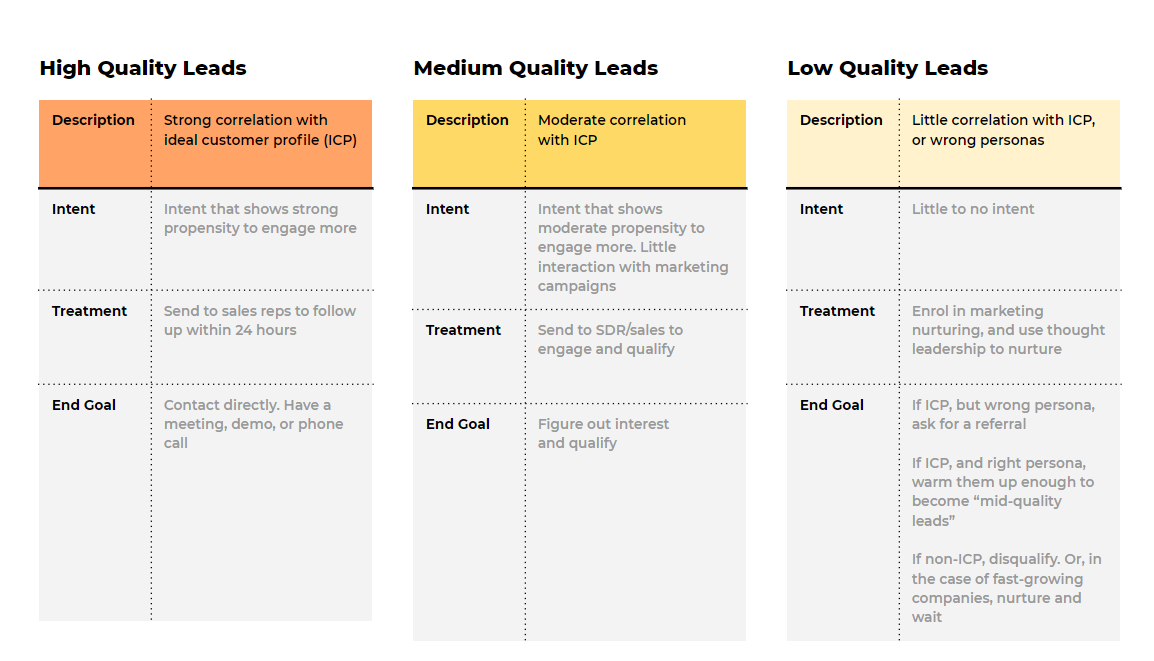
We work with lots of clients who are big on content marketing. They spend plenty of time and resources to produce whitepapers, eBooks, industry reports, etc.
Each piece of content often gets dozens to hundreds of downloads. In fact, according to Content Marketing Institute, 60 to 70% of all B2B content created is never used.
This can make it hard to justify a sustained effort in generating “gated content”. It’s also demoralizing for the team to spend months on content, only to see a handful of downloads.
The best way to get as much mileage out of your content as possible is to run content offer plays.
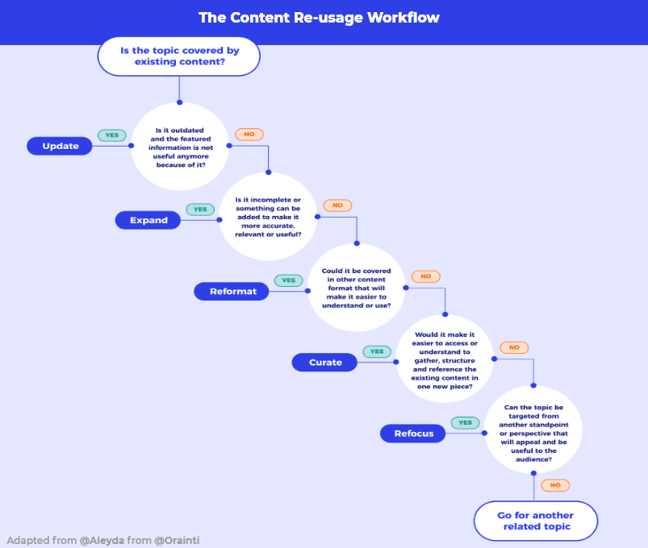
This is good for re-engaging stale leads. Reach out to them and say, “Hi, we recently released this whitepaper for your industry that details the outlook for this year. Would you like to receive a copy?”
In our experience, more than 30% will respond.
Send over the white-paper if they say “yes”. DO NOT push for an ask! “Great! Here you go! Would love to get your thoughts after you had a chance to read it.”
Three days later, follow up. “Hey it’s me, how was the whitepaper? Would appreciate any feedback. Anyways, let me know if you want to discuss more about (value proposition). Happy to jump on a call!”
This is an example of a content offer play. Content is a key part of most marketing strategies. According to HubSpot, 95% of customers buy from companies who give them relevant content at each stage of the buyer's journey. That last bit about relevance is important. Recycle content by putting it in the hands of people who want it AND secure meetings for your sales reps.
Find all the closed-lost deals or “no decision” deals.
Reach out to them as a marketer, in a non-salesy way. Ask these leads why.
Really. Just do it. Like this:
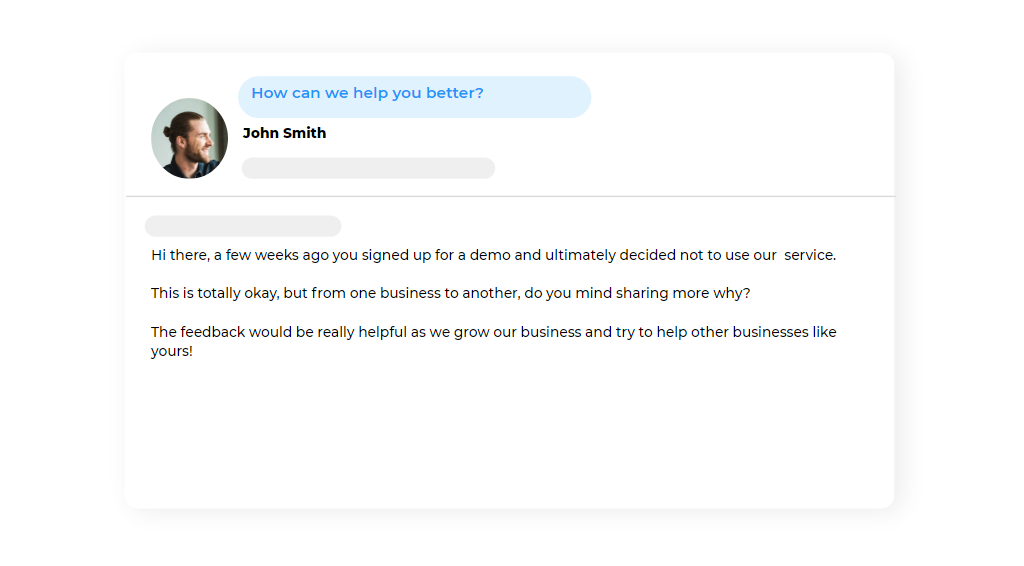
If you’re lucky, some leads will say they are actually keen, and you caught them at the right time.
Most importantly, when leads reply, you get valuable data that can inform your top-of-funnel efforts.
Maybe you get a lot of replies saying, “Oh we thought you were a chatbot, and we were looking for a chatbot. So this is not for us”. Or perhaps “we are just a 10 man company, we have no need for your product”.
Based on the feedback, examine the campaigns you were running to generate these leads. Were you operating under the wrong assumptions? Was your targeting accurate?
Finally, you may also see something like, “oh we were keen but we didn’t hear back from your sales team.” This tells you that you have a sales-marketing SLA problem. If you get a lot of this, it should alarm you, and is something you will need to debug quickly.
The Law of Shitty Clickthroughs is a term coined by Andrew Chen: “Over time, all marketing strategies result in shitty clickthrough rates.”
Consider this:
The first banner ad ever, published back in 1994, had a clickthrough rate of 70%.
17 years later, the average clickthrough rate for a Facebook ad is 0.05%.
It’s not just Facebook ads. From emails to SMSes, many marketing channels suffer from low clickthrough rates.
One way to overcome this is to leverage frontier marketing channels. Bear in mind, though, that all marketing channels eventually succumb to the Law of Shitty Clickthroughs.
So, you will need to stay ahead of the curve.
One way to do so is to form a Growth Team.
At Saleswhale, our Growth Team consists of a product manager, marketer, designer, full-stack engineer, and data analyst.
The charter of the growth team is to leverage cross-functional knowledge, run tight experiments, and search for high-leverage growth opportunities.
This is not about growth hacking. It’s not about A/B testing your call-to-action button colors.
It’s about thoughtful experimentation and process. The discipline and the muscle memory to run experiments. Through these experiments, you are looking to find scalable channels that you can pour more resources into, to generate more sales-ready leads.
We mentioned ABM in section #1. ABM at Saleswhale actually started as an experiment by Yang, who is now our ABM manager.
There was a lot of skepticism about ABM internally at first.
With a budget of $1200, Yang ran a small-scale ABM campaign in Singapore. He managed to generate 11 sales opportunities out of 36 accounts that he targeted.
With these results, the challenge is now to see if we can programmatically scale this to 10X without ballooning our budget and resources linearly.
Marketers today need to be scrappy and make sure they maximize the efficiency of their marketing budgets.
This means leaving no lead behind. Not dormant leads, or even leads that said “no” to your business six months ago.
We hope these five ideas are useful in helping you think about accomplishing more on a lean budget.
It does involve a lot of work, and elbow grease. Especially when it comes to manual and tedious tasks like follow ups.
Some customers ramp up on headcount, such as SDRs.
But if you can't afford to hire, or you want a more scalable and cost-effective solution, use an AI assistant.
At Saleswhale, we deploy AI assistants that engage and qualify leads at scale. Unlike marketing automation platforms, an AI assistant can initiate email conversations with the leads in your database. This includes your "no decision" leads and dormant leads from some time ago.
Use an AI assistant to run content offer plays on your dormant leads and nurture them to book meetings for your sales reps. You can also use it to run Why? campaigns and collect valuable intel on the effectiveness of your marketing campaigns.
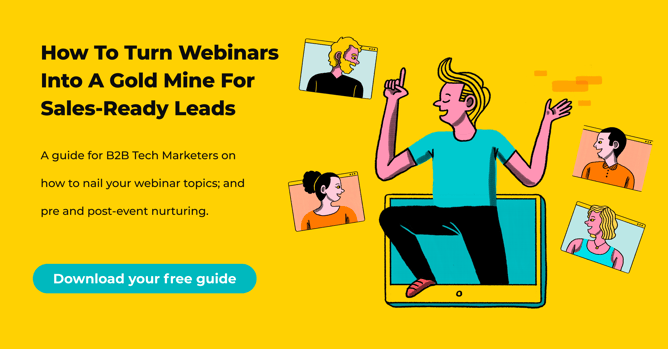


Co-founder & CEO at Saleswhale
Sign up for cutting edge ideas on conversational marketing, AI assistants and martech.
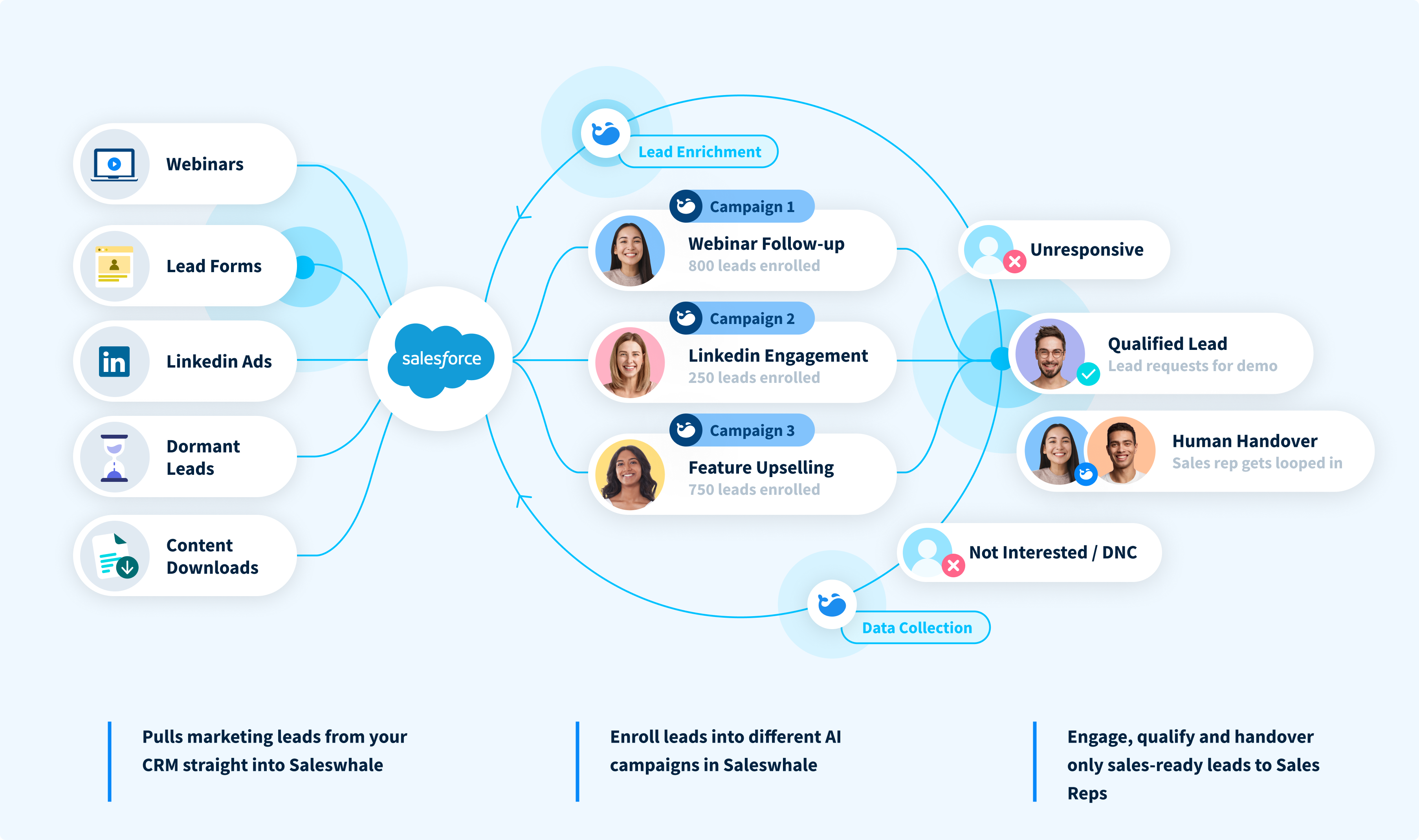
Saleswhale for Salesforce allows you to build powerful automated lead conversion workflows. This allows you to re-engage with your neglected marketing leads at...
19 APR 2021

Demand generation and marketing teams generate more leads at the top of the funnel than ever in this new digital-first world. Saleswhale helps ensure those...
1 MAR 2021

Marketers that focus on MQLs end up doing the wrong things in order to achieve the metrics. So I changed it.
16 JUN 2020

Conversica isn't the only player out there. Learn how Saleswhale and Exceed.ai compare and make an informed decision.
15 APR 2021
By providing your email you consent to allow Saleswhale to store and process the personal information submitted above to provide you the content requested.
You can unsubscribe at any time by clicking the link in the footer of our emails. For information about our privacy practices, please visit our privacy page.